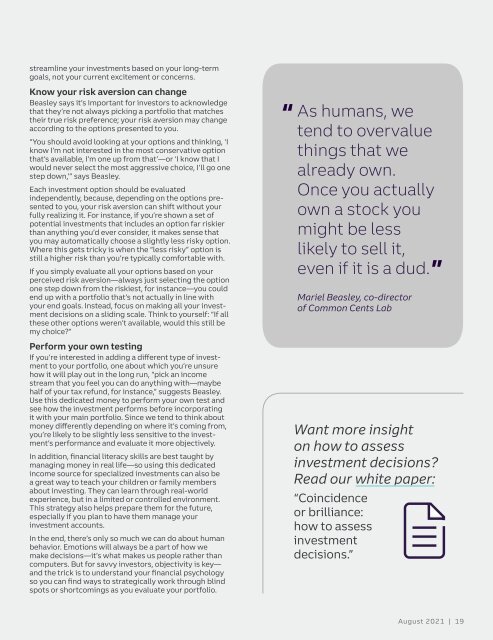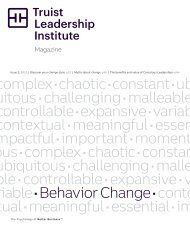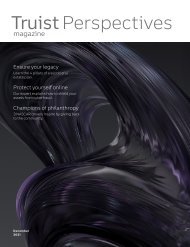Truist-Perspectives-AUGUST_2021
Truist Perspectives magazine makes the complex clear by offering tools and tips for investing, financial planning, and more.
Truist Perspectives magazine makes the complex clear by offering tools and tips for investing, financial planning, and more.
You also want an ePaper? Increase the reach of your titles
YUMPU automatically turns print PDFs into web optimized ePapers that Google loves.
streamline your investments based on your long-term<br />
goals, not your current excitement or concerns.<br />
Know your risk aversion can change<br />
Beasley says it’s important for investors to acknowledge<br />
that they’re not always picking a portfolio that matches<br />
their true risk preference; your risk aversion may change<br />
according to the options presented to you.<br />
“You should avoid looking at your options and thinking, ‘I<br />
know I’m not interested in the most conservative option<br />
that’s available, I’m one up from that’—or ‘I know that I<br />
would never select the most aggressive choice, I’ll go one<br />
step down,’” says Beasley.<br />
Each investment option should be evaluated<br />
independently, because, depending on the options presented<br />
to you, your risk aversion can shift without your<br />
fully realizing it. For instance, if you’re shown a set of<br />
potential investments that includes an option far riskier<br />
than anything you’d ever consider, it makes sense that<br />
you may automatically choose a slightly less risky option.<br />
Where this gets tricky is when the “less risky” option is<br />
still a higher risk than you’re typically comfortable with.<br />
If you simply evaluate all your options based on your<br />
perceived risk aversion—always just selecting the option<br />
one step down from the riskiest, for instance—you could<br />
end up with a portfolio that’s not actually in line with<br />
your end goals. Instead, focus on making all your investment<br />
decisions on a sliding scale. Think to yourself: “If all<br />
these other options weren’t available, would this still be<br />
my choice?”<br />
Perform your own testing<br />
If you’re interested in adding a different type of investment<br />
to your portfolio, one about which you’re unsure<br />
how it will play out in the long run, “pick an income<br />
stream that you feel you can do anything with—maybe<br />
half of your tax refund, for instance,” suggests Beasley.<br />
Use this dedicated money to perform your own test and<br />
see how the investment performs before incorporating<br />
it with your main portfolio. Since we tend to think about<br />
money differently depending on where it’s coming from,<br />
you’re likely to be slightly less sensitive to the investment’s<br />
performance and evaluate it more objectively.<br />
In addition, financial literacy skills are best taught by<br />
managing money in real life—so using this dedicated<br />
income source for specialized investments can also be<br />
a great way to teach your children or family members<br />
about investing. They can learn through real-world<br />
experience, but in a limited or controlled environment.<br />
This strategy also helps prepare them for the future,<br />
especially if you plan to have them manage your<br />
investment accounts.<br />
In the end, there’s only so much we can do about human<br />
behavior. Emotions will always be a part of how we<br />
make decisions—it’s what makes us people rather than<br />
computers. But for savvy investors, objectivity is key—<br />
and the trick is to understand your financial psychology<br />
so you can find ways to strategically work through blind<br />
spots or shortcomings as you evaluate your portfolio.<br />
“<br />
As humans, we<br />
tend to overvalue<br />
things that we<br />
already own.<br />
Once you actually<br />
own a stock you<br />
might be less<br />
likely to sell it,<br />
even if it is a dud.<br />
Mariel Beasley, co-director<br />
of Common Cents Lab<br />
Want more insight<br />
on how to assess<br />
investment decisions?<br />
Read our white paper:<br />
“Coincidence<br />
or brilliance:<br />
how to assess<br />
investment<br />
decisions.”<br />
“<br />
August <strong>2021</strong> | 19










